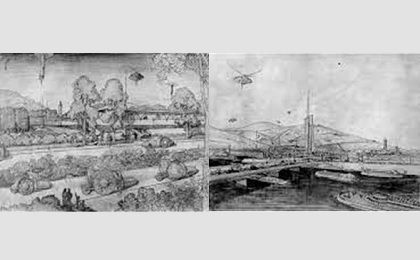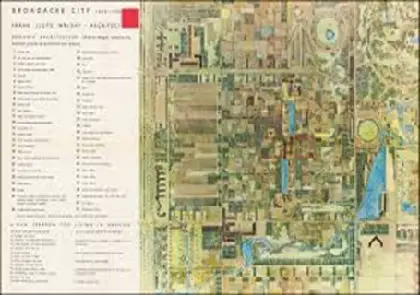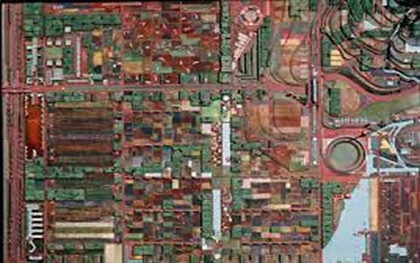The concept of Broadacre city at the time was one of the most daring attempts of envisioning a future city. Frank Llyod Wright is hardly acknowledged for this concept. Much of his biographies do not even mention about this concept. The key issue with this was that Wright never had a chance to design a city according to his concept.
A suburban utopia – it was an ‘anti-city’ concept displayed at the Rockefeller centre at an industrial design fair in 1935. Decorated with skyscrapers and dense urban agglomeration, the location was the complete opposite of what the Broadacre city concept was about. The concept was displayed through a model that was 12 feet square and eight inches high. It represented a low-density modern city, distributed neatly into gridded plots which he would later term as ‘minimum houses.’ With enough spaces available for each dweller’s recreational activity and a couple skyscrapers for the recovering city dwellers who couldn’t give up living in compact spaces, the Broadacre city is nothing different from the American suburbs of the present.

Values behind the Concept
Wright understood the cave instinct of protecting oneself from danger and building fortresses because it was a primal necessity. But it is not required anymore; the continuation of it has only separated humans from each other and from the city itself. Wright believed that democracy is not only a form of government; it should be integrated with all aspects of human life. Later his concept of integration grew into ‘centralized integration’ – to build the city into one consistent plan and to remove patchwork of centralized cities.
The core idea of his concept was that each family will receive one acre of land, with larger families having more land. The distribution of land was unclear as Wright believed in ‘no landlords but society’. Each house would be built with steel and glass exposing the residents to sunlight and would be built to match the landscape of the area. Utility lines would run underground with highways connecting the entire city. Train stations would be replaced by devices of air travel and car service stations would be scattered along the highway which would look more like malls than a gas station. Factories, farms and schools were designated as ‘little’ which were to be built from scratch focusing of simpler and efficient design.

Decentralization and Redistribution
The concept of alienation from other humans living in the city was what Wright predicted correctly. With taller buildings being built, individual interaction among tenants has decreased. The economically stable reside in luxury apartments while the others reside in slums with less and less habitable conditions. The landlord being a powerful agent in the society just crumbles it from its core by depriving people from the sense of belongingness. There has never been a more dire need for Wright’s ‘decentralized integration’ concept where individuals will be bestowed with same quality houses with land that they can use as their own.
Free use of the ground
His believe in fresh food coming from a farm and man being able to produce his own commodities in his backyard is a revelation. With the constant fear of shortage of food supply and rise in population, the need to be able to live self-sufficiently has been alarming. People like Rob Greenfield who foraged his own food for a year make it seem possible. Wright believed that each individual has as much right on land as on air, water and sunlight. Each individual would be their own capitalist.

Economic independence
Being able to own a piece of land free to use it to grow food makes an individual economically independent. Wright was disturbed by capitalism and the human cost of industrialization was something he wanted to remove from his utopia. He believed that machines if used humanely would reduce the workday by half leaving an individual with more time to pursue their own personal interests. Wright knew the evils of consumption which led to the dehumanizing cycle of endless production and labor exploitation. With the security of land ownership, subsistence was certain which would allow workers to refuse severe working conditions and exploitation.
Participation of the People
Wright believed to eliminate politics from government to ensure that monetary exchanges were not made just for the sake of getting re-elected. Broadacre would have only one local government which would work directly under the national government; this allowed public participation in the process and was more democratic. He also insisted that in his utopia people should not keep on waiting for the government to assist them, rather they should work with their own resources and gumption. He didn’t just want to reform but form a new government altogether.

Broadacre City – a relevant experiment
The Broadacre city had seen its fair share of criticism that has rendered it as ‘just a thought experiment’ and ‘a socialist, communist and fascist idea’. Wright’s believe that modern architecture could resolve all the problems of the American society were narrow. With three teachers per university, Wright’s minimalism was straining. That his approach of urban design could solve religious indifferences was again highly ambitious of him. He never even predicted the population explosion.
Wright’s idea may not be permissible from a practical standpoint, but his approach of mitigating the widening gap between the rich and poor, evils of capitalism, obstacles in creating an inclusive community was insightful. Wright may not have been able to provide the most efficient answers, but his questions were right on point which still lingers in today’s society. His thought process could identify that these issues would further separate the society. These questions and many more grapple the very core of our existence which makes Broadacre city concept still relevant.
Author Bio: Ranjana Bhattacharyya, currently pursuing master’s in urban and regional planning, I hail from a small state of India called Assam. I have previously pursued civil engineering, which has connected me to the field of planning as without integration of all no development is possible. I further want to continue my research in the field of urban and regional planning which has a lot of potential, I believe, in India today.
Also Read:
- Sector Model (Hoyt Model) | Urban LandUse Model
- Bid Rent Theory
- Concentric Zone Model by Ernest Burgess | Burgess Model
- Multiple Nuclei Model of 1945 by C.D. Harris and Edward L. Ullman
- Satellite City | Meaning, Characteristics, & Examples
- Christaller’s Central Place Theory | Urban Geography & Economics
References
- https://en.wikipedia.org/wiki/Broadacre_City
- https://franklloydwright.org/reading-broadacre/
- https://www.moma.org/explore/inside_out/2014/02/03/frank-lloyd-wrights-living-city-lives-on-conserving-the-broadacre-city-model/
- https://www.raremaps.com/gallery/detail/46330/broadacre-city-1934-1958-wright
- https://archive.curbed.com/2017/1/4/14154644/frank-lloyd-wright-broadacre-city-history
- https://urbanutopias.net/2020/01/01/broadacre-city/